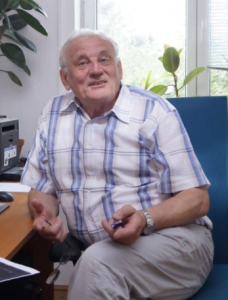Josef Horálek (1948 - 2023)

After a long illness, Josef Horálek, a seismologist from the Institute of Geophysics at the Czech Academy of Sciences, passed away on 5 July 2023, several months before his 75th birthday. Josef worked in the Institute of Geophysics throughout his scientific career, entering in 1972 as a graduate of the Faculty of Electrical Engineering at the Czech Technical University in Prague. The Faculty produced several alumni who were important for the development of broad-band (BB) seismometry, which, at that time, represented a new era in instrumental seismology. The first of these alumni was Axel Plešinger, a world pioneer in BB seismometry. Josef joined Alex Plešinger’s group at the Institute of Geophysics and became his principal co-worker. As such, Josef was involved in the development of the FBV seismic recorder, one of first BB seismometric systems. In the early 1970s, seismometric machinery looked quite different than it does today, and the FBV system itself involved a fairly voluminous set of accessories for storing, reading, and interpreting data. The FBV system consisted of a digital computer (which was the size of a wardrobe), its analog counterpart, a few tape recorders, a filter unit, a digitizer, a computer console, a paper tape puncher, a reader, etc., all occupying two office rooms. Josef was a wizard at maintaining all of this machinery and forcing it to work. In 1974, the system was deployed near Kašperské Hory, in former Czechoslovakia, making KHC the first permanent BB station in the world. The system was also installed in 1978 in Ksiaz (KSP), Poland. Some of the unique data from this pioneer BB era are still available at the IG CAS.
Josef could have filled his professional career by just maintaining and upgrading the BB machinery. However, he expanded his work elsewhere. In the summer of 1985, he and fellow co-worker from Axel’s team, Petr Jedlička, begun to think about deploying a seismic station in West Bohemia, the site of repeating swarm earthquake activity in former Czechoslovakia. Their work was sped up by the occurrence of a magnitude 4.5 earthquake near Nový Kostel during the winter of 1985, which occurred during a strong earthquake swarm in 1985 – 1986.
During the 1985 – 1986 swarm, several temporary analogue and digital stations were set up in West Bohemia. After 1990, a digital network, known as Krasnet, and several other temporary digital stations, were established in the wider West Bohemia region by various Czech institutes. In parallel, Josef prepared a high-quality telemetered seismic network, known as Webnet, that was installed within the swarm region beginning in 1994. The original network consisted of Lennartz instruments and included both PCM 5800 and Mars 88 systems with short-period seismometers (SM3 and Le3D). The development of Webnet coincided with increased interest in West Bohemia by the geophysical community, interest sparked by the German KTB deep drilling project that took place 50 km from the epicentre of the 1985/1986 swarm. During the same period, to monitor KTB operations and seismic activity within the Vogtland region, local seismic networks were also installed in Bavaria and Saxony. Over the years, Webnet has been gradually upgraded and expanded, and now consists of 23 broadband online stations.
The high-quality seismograms recorded by Webnet made it possible to precisely analyse the processes leading to swarm seismicity, typical phenomenon within West Bohemia, where the term "swarm earthquake" was coined at the end of the 19th century. Beginning with precise relocation showing the fine structure of a hypocentre cluster and its migration, Josef and other collaborating researchers from the Institute of Geophysics focused on the analysis of seismic moment tensors. At the turn of the millennium, this work allowed the role of crustal fluids in fault weakening to be elucidated. The understanding of West Bohemian/Vogtland earthquake swarms led Josef to compare this type of seismicity in different tectonic environments. To this end, Josef’s group established a seismic network in the swarm-rich Reykjanes peninsula in Iceland. After a period of dormancy, this decades-long work was rewarded with a series of seismic swarms, culminating in three recent eruptions. The high-quality seismic data acquired during these events will provide a deeper understanding of the nature and genesis of earthquake swarms.
Although CAS researchers do not have direct access to undergraduate students, Josef was active as a lecturer during a great deal of his scientific career. In the Faculty of Science, at Charles University in Prague, Josef taught basic physics for students in applied geophysics and, in addition to seismology, also taught electric methods in geophysical survey. He was keen to seek teaching opportunities because he liked teaching and was interested in finding prospective students for future scientific work. Josef guided several post-graduates and his care for them was, indeed, exemplary. Whenever he found a weak point in the education of one of his students, he filled the gap by himself or arranged additional courses. For Josef, post-graduate students were not only pupils but colleagues.
Josef was a good scientist, and keen to learn and know more about nature and its mysteries. He was highly esteemed by those in his field of work. For us at the Institute of Geophysics, he was a ‘guru’ of seismic instrumentation and local seismicity. We also admired his interest in history, especially modern history, which was his great interest. Josef was a good man and firmly anchored in his Christianity, which was the light behind all his pursuits, both professional and private. He was ready to help in everything with nobility and gentle humor. We will miss our friend Josef daily.
Jan Šílený and Tomáš Fischer
